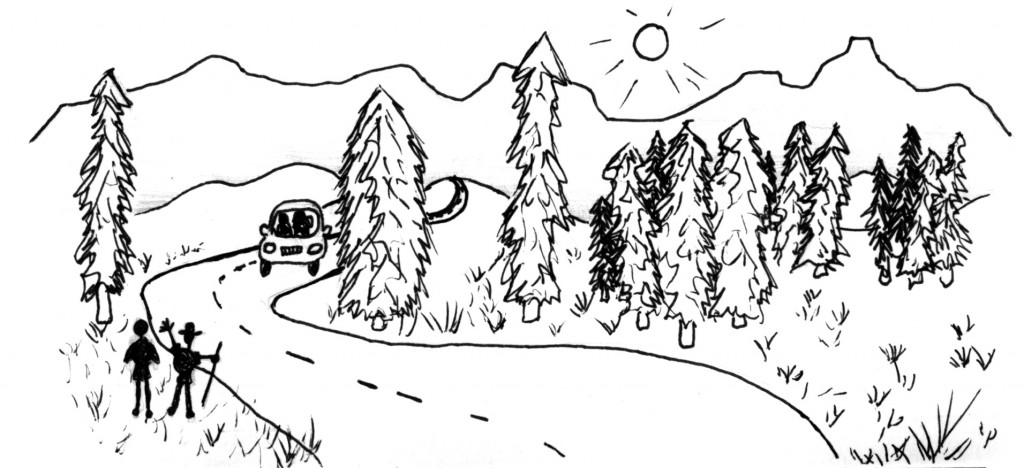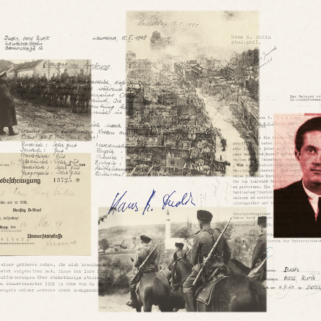 This January, Alison Greenberg ‘13 was driving through rural Bucks County, Pennsylvania with a friend when she saw two men standing on the side of the road. One was tall with dreadlocks, the other smaller, unshaven, wearing baggy jeans, and eating peanut butter ravenously out of a jar. Greenberg and her friend kept driving, but knowing they’d be returning that way, Greenberg texted her friend Jesse Bradford ‘11 for advice.
This January, Alison Greenberg ‘13 was driving through rural Bucks County, Pennsylvania with a friend when she saw two men standing on the side of the road. One was tall with dreadlocks, the other smaller, unshaven, wearing baggy jeans, and eating peanut butter ravenously out of a jar. Greenberg and her friend kept driving, but knowing they’d be returning that way, Greenberg texted her friend Jesse Bradford ‘11 for advice.
Bradford knew a thing or two about hitchhiking. The year after he graduated from Yale, he took a solo trip all the way around the continental United States, relying on strangers to get him from one point on the map to another. “Should we pick these guys up?” Greenberg asked Bradford. “Yeah!” he responded. “Don’t kill them, and don’t get killed.
Greenberg erred on the side of caution in taking this tongue-in-cheek advice. She wanted her would-be passengers to know she would not be messed with. She asked them their names and ages, and checked those against their IDs. She would drive them into Philadelphia, but had some questions for them first: Would they try to take anything from her? Hurt her or her friend? Trash her car? “No, ma’am,” they answered, again and again. Just in case, Greenberg told the hitchhikers–Tom and Beef–that her dad was a Philly cop and that he was on speed dial if they tried anything funny. They didn’t.
In fact, Greenberg noted, Tom and Beef were exceptionally polite and grateful. They claimed it had been three weeks since someone had picked them up. In the meantime they’d been train hopping and walking and had the blisters on their feet to prove it. At a restaurant where Greenberg bought the hitchhikers burgers and milkshakes, Beef, who said he had ADHD and had (falsely, he claimed) been accused of rape, touched her knee. Greenberg felt extremely uncomfortable but shrugged it off: “I think he was just being sweet and had no bad intentions, whatsoever.”
Enthusiasts like Bradford are quick to say that the stereotype of the dangerous hitchhiker is false. In Ginger Gail Strand’s book Killer on the Road: Violence and the American Interstate–which Bradford read while researching the history of hitchhiking–Strand claims that many Americans fear hitchhikers because of images spread by the F.B.I. and police. “The end result is that we have largely turned our backs on the obvious efficiencies—for our wallets as well as the planet—of ride-sharing,” wrote Strand in a New York Times editorial last November, advocating hitchhiking. “And we have lost a way to humanize the landscape of the road.”
The challenge to humanize hitchhiking pushed Bradford to teach a “Hitchhiking 101” workshop at the People’s Art Collective’s (PAC) New Haven Free Skool last fall. He decided to create a one-hour crash course, which he taught to two different groups of students from Yale and the New Haven community.
In the workshops, Bradford conducted role-playing exercises so the class could practice strategies for attracting and interacting with potential rides. Hitchhikers should stand in visible spots on highway entrance ramps and hold signs stating where they’re headed, Bradford explained. For safety’s sake, they should avoid hitchhiking at night, or in inclement weather. Ultimately, a hitchhiker must trust his or her instincts about drivers. “You’re never under an obligation, just because someone pulled over, to get in the car with them” said Bradford.
New Haven native Liba Judd, 18, who volunteers at the PAC, started hitchhiking last year on her way back from an Earth First conference in Pennsylvania. She says she is often asked whether hitchhiking is a more dangerous venture for women than for men, but, like Bradford, she is quick to point out that the same question applies to both driver and hitchhiker: Can you trust strangers? “If somebody’s going to take advantage of a woman, I don’t think it’s likely that hitchhiking is going to exacerbate it,” Judd said.
Of course, a hitchhiker’s success depends as much on drivers’ prejudices as his or her efforts to follow the hitchhiking code. While Bradford, who is white, said he could not speak for hitchhikers of other demographics, he emphasized the general importance of maintaining a clean appearance while on the road.
“Every good hitchhiker or vagabond traveler knows that you wear dark clothes because they hide the dirt and make you look cleaner,” he said. “Also I could see how the time I would have to wait for a ride would get longer as my beard got longer.”
Yet what emerges from talking to Bradford and Greenberg was how the experience, whether hitching or driving, shaped their attitude towards strangers. “I think the true beauty of learning about hitchhiking and picking them up is life-affirming,” Greenberg said. “It’s saying to the world, ‘I’m not afraid to invest in a stranger and to trust them, and to really be vulnerable.’”
Bradford was amazed that single women with small children in their car would stop for him without a question. When he told middle-aged drivers that he regularly slept in ditches, they’d give him money for a motel room. (“Then you buy a beer with the money,” Bradford chuckled, “And you still sleep in a ditch.”)
Greenberg asked Beef and Tom if they would tell her stories, and they did. Tom spoke of the wife who had left him, of the car another hitchhiker stole from him on the way to a Phish concert, of an older woman who made unwanted sexual advances, and of the cousin in Maryland he was trying to reach. Beef came from a wealthy Allentown family and attended St. Paul’s school in New Hampshire, but his family kicked him out of the house. He’d spent time in jail for petty theft before hitting the road.
Bradford, who still lives and works in New Haven, plans on writing a book about his hitchhiking experience to “both share the stories and people that I’ve met, and also talk about the culture of hospitality and the culture of trust.” He picks up hitchhikers whenever he can.
As Judd said, “If you’re in a car with somebody for four hours,” or twelve, as she once had the luck to be, “you’re going to talk to them and get to know them, even if it’s not a really deep relationship.” And any hitchhiker will tell you, that’s much better than nothing.
Illustration by Katharine Konietzko


